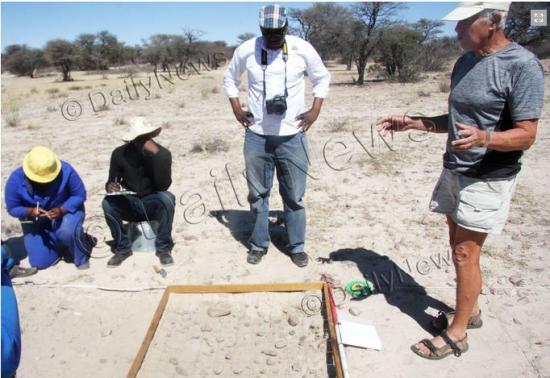Source - http://www.dailynews.gov.bw/news-details.php?nid=23149
 Hardaker (right) with Segadika at the excavation site, explaining artifacts found at Seo Pan pan. With them are field assistants documenting the findings. The pan which is located some 20 km from Tsabong in Maleshe village is earmarked to be a major tourist and research site. Photo: Aobakwe Molefhi
Hardaker (right) with Segadika at the excavation site, explaining artifacts found at Seo Pan pan. With them are field assistants documenting the findings. The pan which is located some 20 km from Tsabong in Maleshe village is earmarked to be a major tourist and research site. Photo: Aobakwe Molefhi
The Department of National Museum and Monuments in partnership with field achaeologists from Oxford, Southampton University, and a geologist from Egypt have come together to do archaeological surveys at Seo Pan near Maleshe, 20km from Tsabong.
In an interview recently, the museum archaeologist, Phillip Segadika revealed that Seo Pan Site had stone tools such as Acheulian handaxes, blades, various flakes, cores and bifacialas that suggested the site had a combination of both the Early and Middle Stone Age relics.
He said from comparative grating of similar artefacts in sites in southern africa, Seo Pan was occupied about 160 000 years ago and even possibly as far as 250 000 years.! “I first discovered in November 2000 when I was then a private consulting archaeologist in the Tsabong water surveys projects” Segadika said.
The site has now been ear marked as a major beneficiary of the Presidential initiative known as the 100 Monuments Project.
He said by April 2016, the site will be open to the public and will have guides and custodians, information boards, brochures, trails and access route developments and in due course, a gate house.
The archaeologist pointed out that in order to undertake the research, the national museum had invited a field archaeologist experienced in desert archaeologists and surface scattered of artefacts, Professor Terry Hardaker, a research fellow at the Ashmolean museum, University of Oxford; Karen van Opstal, an Egyptian based geologist and tour operator who has worked on similar sites in the Sahara; and a marine archaeologist from Southampton University, Dr Rachel Bynoe.
The partnership is an equal sharing one in which all the partcipant institutions and researchers fund their own contribution in the project with the National Museum partially sponsoring the hosting and field costs.
The project started in earnest in 2014 and entailed surveying for similar sites in the sand dunes and pans that unveiled over 25 archaeological sites.
The current field season entailed both archaeological excavation and the training of seven selected local Maleshe community members on the skills of identifying and distinguishing Stone Age tools, site location. Furthermore the excavation work has further confirmed the richness and diversity of Seo Pan Site where on average there were over 15 artifacts per 10 centimetes of layer of square meter excavated, a sign of great intesity in conventional archaeological interpretation.
The project has allowed for collection of uncontaminated sand samples for OSL dating.
Such dating will allow for absolute dating of the context of the stone tools and will bring us close to knowing with certainty at how old Seo pan artifacts were.
Segadika said one exciting thing about Seo Pan is that it is in the same general landscape as the Taung archaeological site across the border in South Africa where remains of early hominid, australo were discovered.